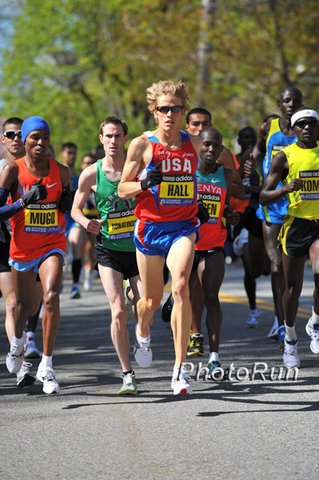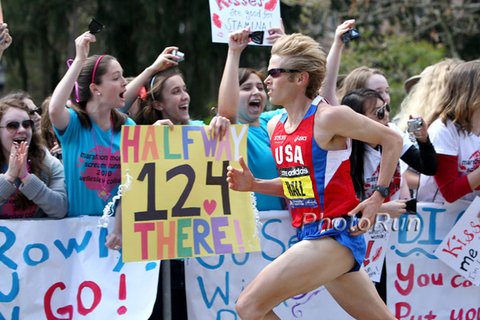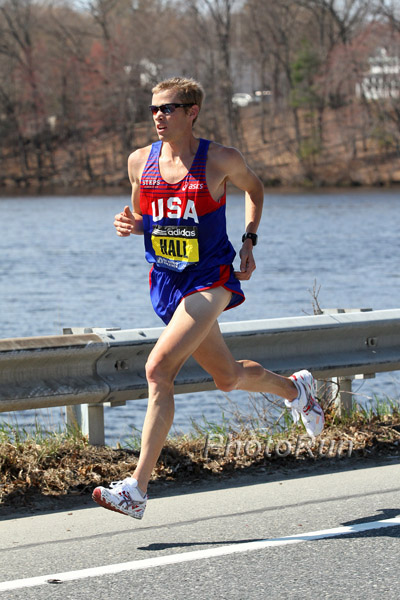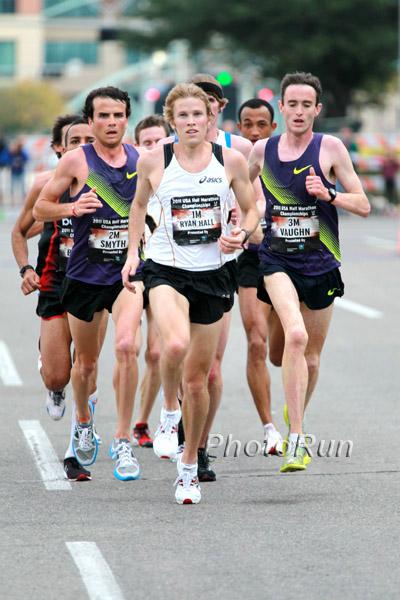
For January 14, 2012, Ryan Hall will be ready. Will he just jog it in, or will Ryan Hall drop a performance for the ages? No one really knows but Ryan Hall. Elliott Denman did this piece for the Winter issue of American Track & Field. We hope that you enjoy it!
NEW YORK – Ryan Hall has seen the Houston Olympic Team Trials-Marathon course and loves it.
But will the Houston route (a 2.2-mile loop starting at the George R.
Brown Convention Center followed by three eight-mile outer loops) love
Ryan Hall?
We’ll know soon enough.
The Marathon Trial date of January 12 is sprinting up on us.
The 29-year-old Californian (Big Bear High School ’01, Stanford ’06)
will head to Texas as defending Marathon Trial champion and rock-solid
choice to win it again.
He’d won the 2008 Trial (actually held Nov. 3, 2007) in New York’s
Central Park) in a convincing 2:09:02 and went on to run 10th at the
Beijing Olympics.
 Ryan Hall, 2011 BAA Boston, photo by PhotoRun.net
Ryan Hall, 2011 BAA Boston, photo by PhotoRun.net And he’s lowered his PR since then from 2:06:17 (London, 2008) to
2:04:58 (albeit on the now-asterisked Hopkinton-to-Boston route, April
18th.)
Stats-wise, that should make him a leadpipe cinch to romp home a
winner in Houston. The Marathon Trial qualifying window has been open
since 2009 and just one other man, Meb Keflezighi (with 2:09:15, 2:09:21
and 2:09:26 clockings) has broken 2:10. The window closes on Dec.
11th.
But Hall is counting no chickens and taking the
anything-can-happen-on-a-given day approach. He knows that “Meb” (2009
ING NYC champion and 2004 Olympic silver medalist) can always climb the
sport’s greatest heights. And he knows that any of the several “young
guns” who’ve clocked super times over the half-marathon or 10k routes
have the potential to stun the formchart-makers.
“I love the Houston course (which he’s checked on inspection tours)
and it’s got a great feel to it,” he reports. “It kind of replicates the
Olympic course in London so if I make the team I’ll pretty much know
what to expect. It should be great for the spectators and great for the
runners, too. We’ll see everybody else and can make frequent checks on
what’s going on behind us (or ahead.)
“Oh, it’s got a few ups and downs, but not too many. Basically, it’s pretty much ideal.
“Man, I really think I can run quick on it.”
Up to 1964, the Olympic Marathon team was generally chosen on the
combined results of multiple Trials races. But in 1968, the format
switched to a single Trial event and has stayed that way since.
Hall will be running for the history books in another important way. Since 1968, no man has managed to win it (outright) twice in a row. Closest to the
feat was Frank Shorter who (en route to his Munich Olympic gold medal
performance) shared the 1972 Trials crown with Kenny Moore and then won
it on his own in 1976.
The rollcall of winners since then: Tony Sandoval 1980; Peter
Pfitzinger 1984; Mark Conover 1988; Steve Spence 1992; Bob Kempainen
1996; Rod DeHaven 2000; Alan Culpepper 2004…and Hall in 2008.
Hall dares not make any time predictions for Houston, but knows that
“if we get a nice day, without too much wind, it will be definitely
possible to run sub-2:06.”
If Hall needs further inspiration, it came at the recent Pan American
Games in Guadalajara, Mexico, where he saw wife Sara run off with the
gold medal in the women’s 3,000-meter steeplechase final.
“Oh, Sara was just great at the Pan Ams,” he said. ” She ran a powerful
race and beat a quality field. (And now has the problem of choosing her
primary Olympic event for 2012.)
 Ryan Hall, 2011 BAA Boston, photo by PhotoRun.net
Ryan Hall, 2011 BAA Boston, photo by PhotoRun.net“It was fun to be there and fun to watch her win.”
But he couldn’t really relish the full occasion because he had a
flight to catch and corporate appointments to make and photoshoots to do
back “north of the border.”
He handled lots more corporate business to the backdrop of the ING NYC Marathon,
but couldn’t wait to head out to resume full focus on training for Houston.
He has no regrets about running the Bank of America Chicago Marathon
(in 2:08:04 on October 9) and considers it the prefect prep for
Houston. (While most other leading Americans stayed away.)
“I got to run against a quality field and got to see where I stood
with runners that good,” he stressed. “I tried a little bit of new stuff
and am sure I learned a lot from running it. “
Now it will be back to his alternating training bases in Flagstaff,
Arizona and Redding, California. Flagstaff’s perfect for altitude
preparation, Redding for tempo work. High-volume cycles will rotate
sessions of high-speed work.
While passing up the 2011 ING NYC Marathon, he still “caught the fever”
of the Big Apple classic. Apart from the Olympic Trial race in 2007
(held on a loop course in Central Park), he’d run just one previous NYC
26.2-miler.
That was 2009 when he ran a disappointing-to-himself (but not many others) 2:10:36.
“I was kind of flat going in and made some mistakes back in 2009,” he
remembers. “For one thing, I went out too fast. The first five miles
felt like I was in a five-mile race. By 18 miles, I was pretty much
struggling.
“But that performance, and knowing I can do a lot better, only makes me hunger to go back sometime.”
A perfect time to return to NYC would seem to be November 2012 –
hopefully, after a major Trials performance, an up-with-the-leaders
finish in the London Olympic Games, and a return home to tackle all the
other goals that have been placed on hold.
Beyond NYC, there’s a much-longer, much-tougher one.
That’s the Rim to Rim and Back 41.8-mile (with 10,710 feet of ups and
downs) course at the Grand Canton in Arizona. The path starts on the
South Rim, descends the South Kaibab Trail, crosses the Colorado River,
then rises up the North Rim on the North Kaibab Trail. And then it’s
back the same way.
The men’s record of 6:56:59 was set by Dave Mackey in 2007.
With all his training work at Flagstaff, about an hour-plus from
Grand Canyon, he’s gained new appreciation of what that one would
entail.
It’s already on his “bucket list..” He knows it would be the fun jaunt of his life.
And that’s what he always wants his running to be – fun.
“I have this short period in my life to be a world-class runner,” he
philosophizes. “It’s given me some great opportunities. And I want to
enjoy everyone of them.”
 Ryan Hall, 2011 Houston, USA Half Marathon,
Ryan Hall, 2011 Houston, USA Half Marathon, photo by PhotoRun.net
RelatedPosts
Author

Larry Eder has had a 52-year involvement in the sport of athletics. Larry has experienced the sport as an athlete, coach, magazine publisher, and now, journalist and blogger. His first article, on Don Bowden, America's first sub-4 minute miler, was published in RW in 1983. Larry has published several magazines on athletics, from American Athletics to the U.S. version of Spikes magazine. He currently manages the content and marketing development of the RunningNetwork, The Shoe Addicts, and RunBlogRun. Of RunBlogRun, his daily pilgrimage with the sport, Larry says: "I have to admit, I love traveling to far away meets, writing about the sport I love, and the athletes I respect, for my readers at runblogrun.com, the most of anything I have ever done, except, maybe running itself." Also does some updates for BBC Sports at key events, which he truly enjoys. Theme song: Greg Allman, " I'm no Angel."
View all posts


















